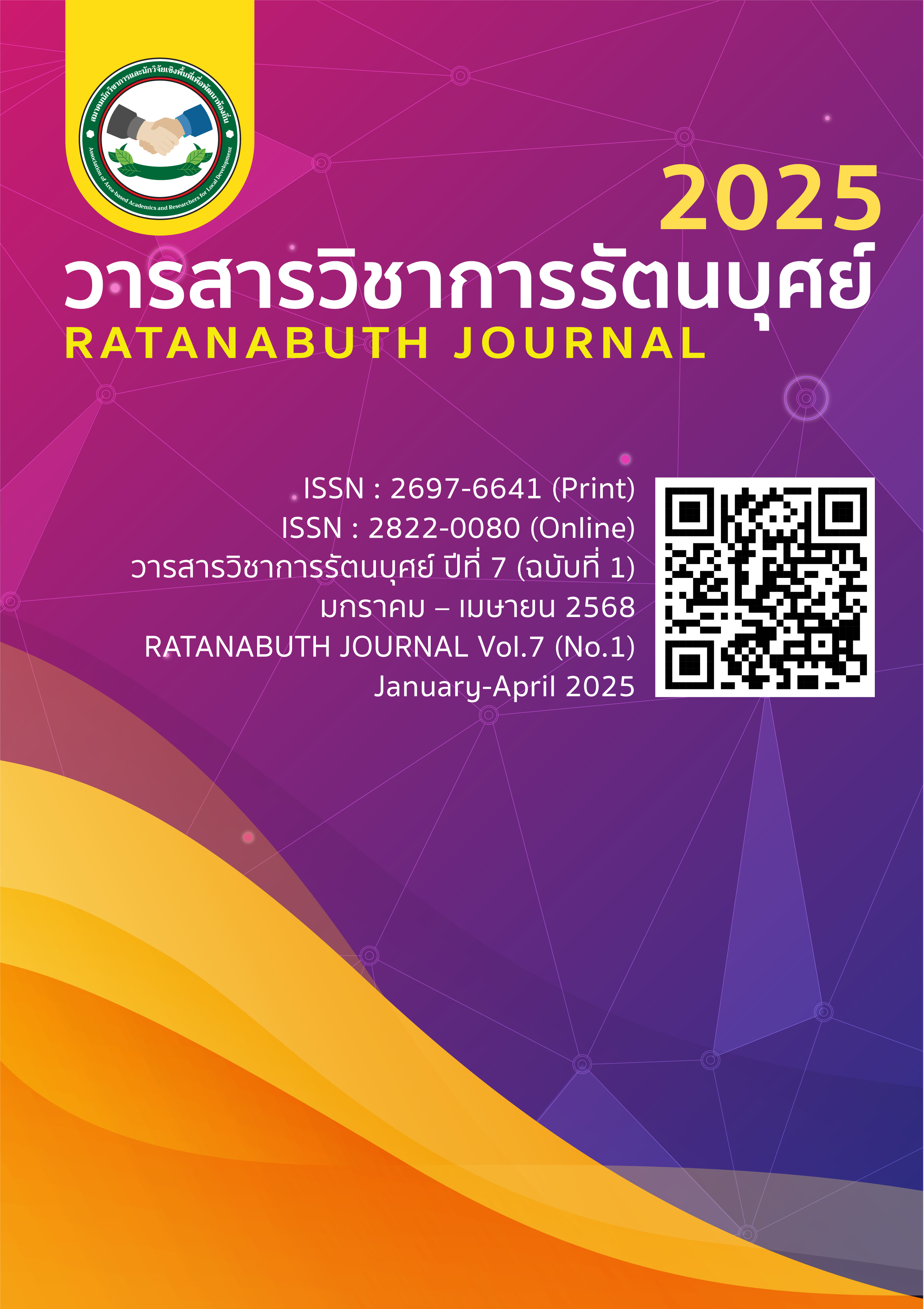กลยุทธ์การอนุรักษ์และการพัฒนาวัฒนธรรมอย่างยั่งยืนของสถาบันการศึกษาไป๋ลู่ตง เมืองลู่ซาน มณฑลเจียงซี สาธารณรัฐประชาชนจีน Sustainable Cultural Protection and Development Strategies of Bailudong Academy in Lushan, Jiangxi, The People's Republic of China
Main Article Content
บทคัดย่อ
สถาบันการศึกษาไป๋ลู่ตง เมืองลู่ซาน มณฑลเจียงซี สาธารณรัฐประชาชนจีน เป็นสถานที่สำคัญทางประวัติศาสตร์ เริ่มตั้งแต่ช่วงปลายในสมัยราชวงศ์ถัง มีบทบาทสำคัญเป็นทรัพยากรทางศิลปะวัฒนธรรม มีคุณค่าเชิงสัญลักลักษณ์หลายด้าน จึงมีความสำคัญต่อการอนุรักษณ์และพัฒนาให้ยั่งยืน โดยมีวัตถุประสงค์ของการวิจัยนี้คือ 1) เพื่อศึกษาคุณค่าทางวัฒนธรรมและบทบาทของสถาบันการศึกษาไป๋ลู่ตง ในลู่ซาน 2) เพื่อวิเคราะห์หาแนวทางการอนุรักษ์และพัฒนาของมรดกทางวัฒนธรรม ของสถาบันการศึกษาไป๋ลู่ตง ในเมืองลู่ซาน ให้เกิดความยั่งยืน 3) เพื่อนำเสนอรูปแบบกลยุทธ์แนวการอนุรักษ์และพัฒนาสถาบันการศึกษาไป๋ลู่ตง ในภูเขาลู่ซาน มณฑลเจียงซี สาธารณรัฐประชาชนจีนอย่างยั่งยืน การวิจัยใช้แบบผสมผสาน โดยทบทวนวรรณกรรมจากหนังสือ ตำราเรียน บทความวิชาการและแหล่งข้อมูลอื่น ๆ เพื่อพัฒนากรอบทฤษฎี สัมภาษณ์แบบกึ่งโครงสร้างกับผู้มีส่วนได้ส่วนเสียที่สำคัญ ประชากรกลุ่มตัวอย่างได้แก่ ผู้บริหารของสถาบันการศึกษา เจ้าหน้าที่บริหารการท่องเที่ยว นักวิชาการ นักวิจัยในสาขาที่เกี่ยวข้องประกอบด้วยบุคลากรสำคัญจากสถาบันการศึกษา 10 คน ประชาชน 60 คน นักท่องเที่ยว 200 คน และเจ้าหน้าที่ 10 คน การวิเคราะห์ข้อมูลโดยใช้เครื่องมือซอฟต์แวร์ Nvivo ใช้สำหรับแยกแยะรูปแบบและความสัมพันธ์ สำหรับข้อมูลเชิงคุณภาพและกระบวนการลำดับชั้นเชิงวิเคราะห์กึ่งโครงสร้าง (AHP) สำหรับข้อมูลเชิงปริมาณ ซึ่งนำไปสู่กลยุทธ์ที่ดำเนินการได้สำหรับการพัฒนาอย่างยั่งยืนและผลประโยชน์ทางเศรษฐกิจ กรอบงานนี้สนับสนุนโดยการจำลองกระบวนการลำดับชั้นเชิงการวิเคราะห์ อันจะช่วยให้สามารถวัดสถานะการพัฒนาทางวัฒนธรรมของสถาบันได้อย่างเป็นวิทยาศาสตร์และเป็นกลาง และเป็นแนวทางในการกำหนดกลยุทธ์ที่กำหนดเป้าหมายและดำเนินการได้เพื่อความยั่งยืนในระยะยาว
Article Details

This work is licensed under a Creative Commons Attribution-NonCommercial-NoDerivatives 4.0 International License.
References
มหาวิทยาลัยซานตง. (2561). การคุ้มครองและการวิจัยอาคารโบราณลีเจียตวน. ซานตง: สำนักพิมพ์มหาวิทยาลัยซานตง.
สำนักบริหารมรดกทางวัฒนธรรม. (2555).มรดกโลกในประเทศจีน.สืบค้นเมื่อ 16 สิงหาคม 2567, จาก https://www.gov.cn/guoqing/2012-04/11/content_2584145.htm.
Agapiou, A., Lysandrou, V., Alexakis, D. D., Themistocleous, K., Cuca, B., Argyriou, A., Sarris, A., & Hadjimitsis, D. G. (2015). Cultural heritage management and monitoring using remote sensing data and GIS: The case study of Paphos area, Cyprus. Computers, Environment and Urban Systems, 54, 230–239. https://doi.org/10.1016/j.compenvurbsys.2015.09.003.
Chrysostomou, C., Kyriakides, N., Roussis, P. C., & Asteris, P. G. (2005). Emerging technologies and materials for the seismic protection of cultural heritage. In Handbook of research on seismic assessment and rehabilitation of historic structures, 12(2),197–212. IGI Global.
CRL online. (2024). Hutong and Siheyuan. Retrieved from https://thai.cri.cn.
Deretić, N., & Kukolj, S. (2023). Application of new technologies in the promotion and preservation of cultural heritage. Thematic Proceedings, 309–318.
Jansen, L. (2003). The challenge of sustainable development. Journal of Cleaner Production, 11(3), 231–245. https://doi.org/10.1016/S0959-6526(02)00038-6
Kan, L. (2022). Study on the value of family identity of ancient architecture group and its enlightenment: A case study of Xicun Square in Hunan Province. https://www.sohu.com.
Korro Bañuelos, J., Rodríguez Miranda, Á., Valle-Melón, J. M., Zornoza-Indart, A., Castellano-Román, M., Angulo-Fornos, R., Pinto-Puerto, F., Acosta Ibáñez, P., & Ferreira-Lopes, P. (2021). The role of information management for the sustainable conservation of cultural heritage. Sustainability, 13(8), 4325. https://doi.org/10.3390/su13084325.
Liritzis, I., Al-Otaibi, F., & Volonakis, P. (2015). Digital technologies and trends in cultural heritage. Mediterranean Archaeology and Archaeometry, 15(3), 313–323.
Ma, H., Li, S., & Chan, C.-S. (2018). Analytic hierarchy process (AHP)-based assessment of the value of non-World Heritage Tulou: A case study of Pinghe County, Fujian Province. Tourism Management Perspectives, 26(1), 67–77. https://doi.org/10.1016/j.tmp.2017.10.007.
Mekonnen, H., Bires, Z., & Berhanu, K. (2022). Practices and challenges of cultural heritage conservation in historical and religious heritage sites: Evidence from North Shoa Zone, Amhara Region, Ethiopia. Heritage Science, 10(1), 172. https://doi.org/10.1186/s40494-022-00805-w.
Milošević, M. R., Milošević, D. M., Stanojević, A. D., Stević, D. M., & Simjanović, D. J. (2021). Fuzzy and interval AHP approaches in sustainable management for the architectural heritage in smart cities. Mathematics, 9(4), 304. https://doi.org/10.3390/math9040304.
Nocca, F. (2017). The role of cultural heritage in sustainable development: Multidimensional indicators as decision-making tool. Sustainability, 9(10), 1882. https://doi.org/10.3390/su9101882.
Pearce, S. M. (2000). The making of cultural heritage: Values and heritage conservation. Los Angeles: The Getty Conservation Institute.
Pereira Roders, A., & Van Oers, R. (2011). Bridging cultural heritage and sustainable development. Journal of Cultural Heritage Management and Sustainable Development, 1(1), 5–14. https://doi.org/10.1108/20441261111129906.
Qi, Y. (2017). Towards decline: A review of the cultural and historical evolution of Bailudong Academy. Legal System and Society, 8(1), 247.
Roy, D., & Kalidindi, S. N. (2017). Critical challenges in management of heritage conservation projects in India. Journal of Cultural Heritage Management and Sustainable Development, 7(3), 290–307. https://doi.org/10.1108/JCHMSD-06-2016-0033.
Wei, S. (2021). A study on Zhu Xi's higher education thought: Based on school and imperial examination private discussion and Bailudong Academy revelation. Master’s thesis, Hunan Normal University.

